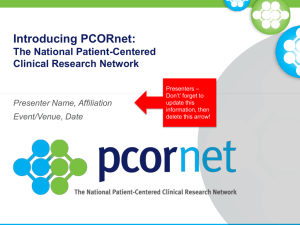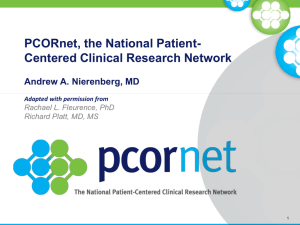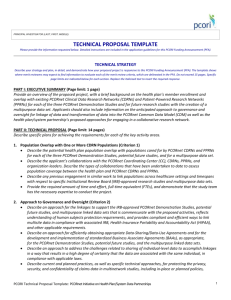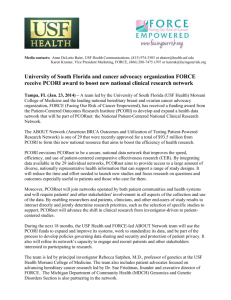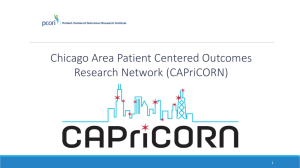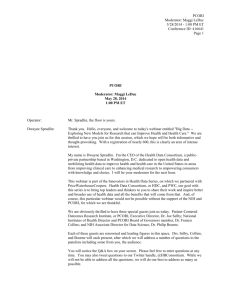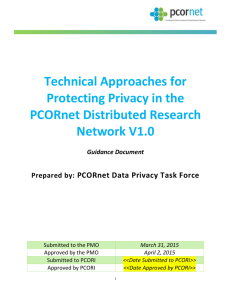Introducing PCORnet - CCFA Partners / PCORI PPRN Kickoff Meeting
advertisement
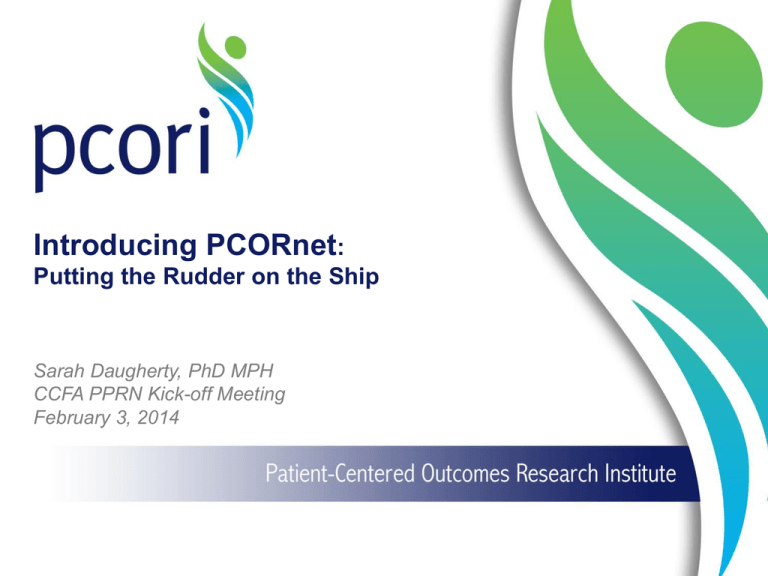
Introducing PCORnet: Putting the Rudder on the Ship Sarah Daugherty, PhD MPH CCFA PPRN Kick-off Meeting February 3, 2014 PCORnet: the National Patient-Centered Clinical Research Network The goal of PCORI’s National Patient-Centered Clinical Research Network Program is to improve the nation’s capacity to conduct clinical research more efficiently, by creating a large, highly representative, national patientcentered clinical research network with a focus on conducting CER – both randomized and observational. The vision is to support a learning US healthcare system, which would allow for large-scale research to be conducted with enhanced accuracy and efficiency within real-world care delivery systems. 2 Patient-centeredness is at the heart of PCORI’s name, and of its mission and vision An independent, non-profit health research organization authorized by the Patient Protection and Affordable Care Act of 2010. PCORI funds patient-centered research to assist patients, caregivers, and other stakeholders in making informed health decisions. Mission PCORI helps people make informed healthcare decisions and improves healthcare delivery and outcomes by producing and promoting high integrity, evidence-based information that comes from research guided by patients, caregivers, and the broader healthcare community. Vision Patients and the public have the information they need to make decisions that reflect their desired health outcomes. 3 4 Overall objectives of PCORnet: achieving a single functional research network Building a “network of networks” with inter-operable EHR, claims and and patient-reported data on millions of individuals Engagement of patients, providers and health system leaders Support and conduct of multi-center observational and interventional CER studies External data and research partners participate with PCORI-funded networks Researchers not directly affiliated with PCORnet participate through collaborative arrangements. PCORnet partners use the resources created with PCORI’s support for a range of research activities supported by PCORI and other sponsors. 5 Clinical Data Research Network Partners 6 Goals for Clinical Data Research Networks (CDRNs) Extracts from EHR data are standardized within PCORnet Complete, longitudinal clinical data on a minimum of 1 million patients within 18 months Individual network’s data in interoperable format with other awardee networks and successfully responds to queries Willingness, capability of implementing clinical trials Patients, health system leaders, and clinicians involved in governance and use of network At least three patient cohorts identified, characterized, and surveyed 7 11 CDRNs CDRN Name Lead Organization Principal Investigator ADVANCE Oregon Community Health Information Network Jennifer DeVoe CAPriCORN The Chicago Community Trust Terry Mazany Great Plains Collaborative University of Kansas Medical Center Lemuel Waitman Louisiana Clinical Data Research Network Louisiana Public Health Institute Anjum Khurshid Mid-South CDRN Vanderbilt University Russell Rothman NYC-CDRN Weill Medical College of Cornell University Rainu Kaushal PEDSNet The Children’s Hospital of Philadelphia Christopher Forrest PORTAL Kaiser Foundation Research Institute Elizabeth McGlynn pSCANNER University of California, San Diego Lucila Ohno-Machado P2ATH University of Pittsburgh Rachel Hess SCIHLS Harvard University Kenneth Mandl 8 CDRNs Disease Cohorts Organization Common Cohort Rare Cohort ADVANCE Diabetes Co-infection with HIV and hepatitis C virus CAPriCORN Anemia; Asthma Sickle cell disease; Recurrent C. Difficile colitis Great Plains Collaborative Breast Cancer Amyotrophic Lateral Sclerosis (ALS) Louisiana Clinical Data Research Network Diabetes Sickle Cell Disease, Rare Cancers NYC-CDRN Diabetes Cystic fibrosis Mid-South CDRN Coronary Heart Disease (CHD) Sickle Cell Disease (SCD) PEDSNet Inflammatory bowel disease Hypoplastic left heart syndrome PORTAL Colorectal Cancer Severe Congenital Heart Disease pSCANNER Congestive Heart Failure Kawasaki Disease P2ATH Atrial Fibrillation Idiopathic Pulmonary Fibrosis SCIHLS Osteoarthritis Pulmonary arterial hypertension 9 Patient Powered Research Network Partners 10 Goals for Patient Powered Research Networks (PPRNs) Target size of 0.5% of U.S population with condition: (> 50 patients for rarest diseases; 50,000 for most common) Patient-reported data collected for at least 80% of cohort Patients involved in governance Standardized data suitable for sharing with other infrastructure members and successfully responds to queries 11 PPRNs represent a number of conditions… Organization PI Condition Accelerated Cure Project for Robert McBurney Multiple Sclerosis American Sleep Apnea Association Susan Redline Multiple Sclerosis Proposed PPRN Population Size 20,000 Sleep Apnea 50,000 Cincinnati Children's Hospital Medical Center COPD Foundation Peter Margolis Pediatric Crohn's Disease and Ulcerative Colitis 15,000 Richard Mularski Chronic Obstructive Pulmonary Disease 50,000 Crohn’s and Colitis Foundation of America Global Healthy Living Foundation R. Balfour Sartor 30,000 Univ of California, San Francisco Inflammatory Bowel Disease (Crohn’s disease and ulcerative colitis) Seth Ginsberg Arthritis (rheumatoid arthritis, spondyloarthritis), musculoskeletal disorders (osteoporosis), and inflammatory conditions (psoriasis) Andrew Nierenberg Major Depressive Disorder (MDD) and Bipolar Disorder (BP) Mark Pletcher Cardiovascular health University of South Florida Rebecca Sutphen 17,000 Massachusetts General Hospital Hereditary Breast and Ovarian Cancer (HBOC) 12 50,000 50,000 100,000 ….including rare diseases Organization PI Condition Proposed PPRN Population Size ALD Connect, Inc Florian Eichler Adrenoleukodystrophy Arbor Research Collaborative for Health Bruce Robinson Primary Nephrotic Syndrome (Focal Segmental Glomerulosclerosis 1,250 [FSGS], Minimal Change Disease [MCD], and Membranous Nephropathy [MN] Multiple Sclerosis Duke University Laura Schanberg Juvenile Rheumatic Disease 9,000 Epilepsy Foundation Janice Beulow Aicardi Syndrome, Lennox-Gastaut Syndrome, Phelan-McDermid Syndrome, Hypothalamic Hamartoma, Dravet Syndrome, and Tuberous Sclerosis 1,500 Genetic Alliance, Inc Sharon Terry Alström syndrome , Dyskeratosis congenital, Gaucher disease, Hepatitis, Inflammatory breast cancer, Joubert syndrome, Klinefelter syndrome and associated conditions, Metachromatic leukodystrophy, Pseudoxanthoma elasticum (PXE), Psoriasis Immune Deficiency Foundation Kathleen Sullivan Primary Immunodeficiency Diseases 1,250 Parent Project Muscular Dystrophy Holly Peay Duchenne and Becker muscular dystrophy 4,000 Phelan-McDermid Syndrome Foundation Megan O’Boyle Phelan-McDermid Syndrome 737 University of Pennsylvania Peter Merkel Vasculitis 500 3,000 13 50- 50,000 PCORnet Synergy Outreach Methods Data access policies Informed Consent PCORnet Data Infrastructure Communication Strategy Engagement Tools Governance Models Outreach and Sustaining Engagement • Optimizing plans for participants to report new data over time. • Maximizing engaged retention • Methods to collect feedback • Competencies and skills needed for effective partnership • Communication vehicles • Impact of PCORnet Sustaining Engagement Awareness Assessment Outreach • Approaches used to identify hard to reach populations Some takeaways We need a new national capability for efficient, large-scale interventional and observational patient- centered research PCORnet will need to: Establish priorities that patients, clinicians, clinical leaders, and investigators share Facilitate trust leading to collaboration between networks Embed research into practice settings without disrupting clinical operations Create a distributed data network that protects patients’ confidential information Develop oversight procedures that protect patients while minimizing redundancy Engage individuals and organizations beyond the initial awardees 16 17
